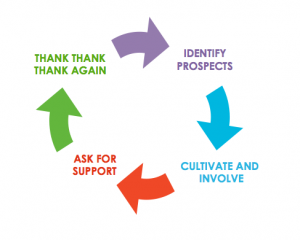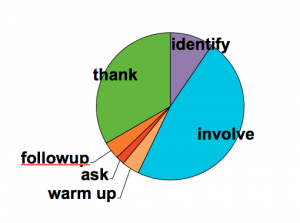 By Gail Perry, president, Gail Perry Associates/Firedupfundraising.com
By Gail Perry, president, Gail Perry Associates/Firedupfundraising.com
This post is one in our series written by nonprofit leaders who will be presenting sessions at the BoardSource Leadership Forum (BLF) taking place on October 9 & 10 in Washington, DC. We hope you’ll be joining us.
Whose job is it to raise funds for your organization? Many leaders want to keep the fundraising monkey on YOUR back, not theirs! It’s everyone’s job to support fundraising — both board AND staff. And there are many ways to support fundraising that don’t even involve soliciting funds.
When it comes to your board, you can count on this: Board members are almost always afraid of fundraising. That’s because many board members don’t understand how fundraising really works. They think it’s all about “asking” rather than building long-term relationships with donors who stick with you. You can almost bet that they will throw the fundraising monkey on YOUR back if they possibly can. This is an uncomfortable — and perhaps untenable — spot for a staff fundraiser.
Here are some strategies to help get the fundraising monkey on EVERYBODY’S back, not just yours.
1. Help board members understand the many roles they can play to support fundraising.
You know that there are many, many fundraising activities that happen at your nonprofit. And most of these do NOT involve asking for money. Here are some of the roles board members can play:
 Many board members don’t understand the major gifts fundraising cycle.
Many board members don’t understand the major gifts fundraising cycle.
- Help write thank-you letters.
- Make their own proud gift and invite others to join them in giving.
- Make introductions for you to potential donors.
- Have “listening” conversations with prospects to find out their hot buttons.
- Host small socials and cultivation events.
- Make thank-you visits or phone calls to donors.
- Be sure the fundraising office is adequately funded and staffed with a smart plan.
- Sell tickets and sponsorships to your events.
2. Help board members understand smart fundraising strategy — and the donor pyramid.
About 20 gifts from 20 wonderful people could account for a major inflow of money to your organization. So you could focus everyone on seeking 20 top gifts. Those gifts will come from about 60 prospects. (Remember you want three prospects for every gift you need to close.)
Time and energy required for each fundraising step. Many roles for board members!
Once board members understand that major gift fundraising focuses on just a few people for deep cultivation, then they are often more willing to get involved in relationship development efforts.
3. Stage a training session about how major gift fundraising really works.
Board members typically ARE interested in “education.” They like learning new things. And they want the skills and information they need to be successful. But your training format is key. Giving them a PowerPoint presentation WON’T WORK. Instead, you have to ENGAGE them in discussions so that they have to incorporate the knowledge into their own experience. Otherwise they will just sit passively letting you do all the talking — and then they’ll sit back and let you do all the work. Engage them in real discussions: “Why should someone support our organization?” “Why do you care about our organization?” “How do our various fundraising programs work — how actually do we raise our money?” You’ll get into your board members’ heads and open them up to new ideas.
4. Ask board members: “What is the board’s role in our fundraising efforts?”
When confronted with this question, it is hard for a board member to evade responsibility.
There are many jobs for board members in major gifts fundraising! Break them into small groups and ask each group to come up with five different activities that board members can do to support fundraising. You’ll be surprised! (And pleased.)
5. Change your language and start using words that imply “team.”
Stop using the words “I” and “you” and start using the word “we.” Many staffers talk to the board members in these terms: “I need you to do this and this…” Or, “I can’t do all this by myself.” Instead, start saying, “We need to do this.” And, “How are WE doing to get this done?”
6. Get a knowledgeable and supportive board member or two on your side.
It’s hard for you to rally the board members because you work for them. You are automatically “one-down” from the board. But other board members are peers. They can speak as equals to the other board members. They can rally the troops in a way that you can’t. So “hide behind” a board member or two — and let them speak to and encourage the group.
7. Enlist a special outside fundraising committee.
Many fundraising staffers create separate groups of volunteers to work with them on fundraising projects. Why? Because board members are not typically recruited for their fundraising skills. (We wish!) You could enlist a special Development Committee made up of people who are ONLY enlisted because of their personal networks and their ability to raise money. I’d hate for you to spend a lot of time banging your head against the wall with board members who don’t understand — or are afraid of — fundraising! Try enlisting outside help, and you just might get on the road to a successful major gifts effort. Be practical and conserve your energy.
BOTTOM LINE:
It’s up to you to educate, train, motivate and inspire your board members to actively support fundraising. And you CAN do it! But if you’d like some help, check out my BLF session.



